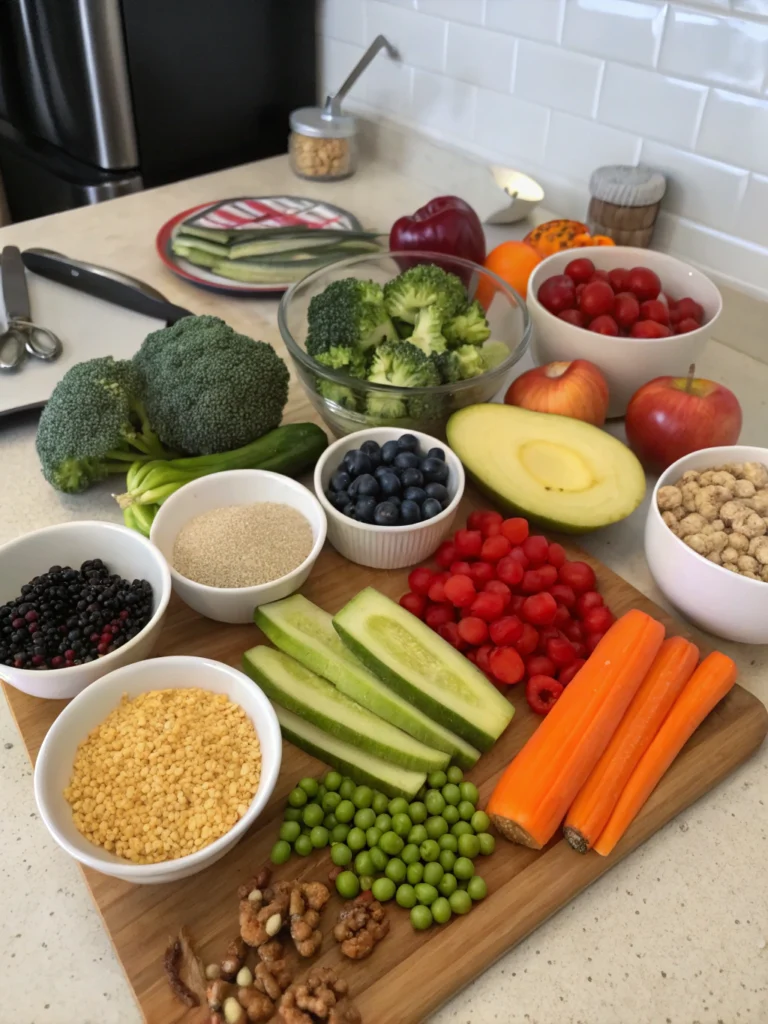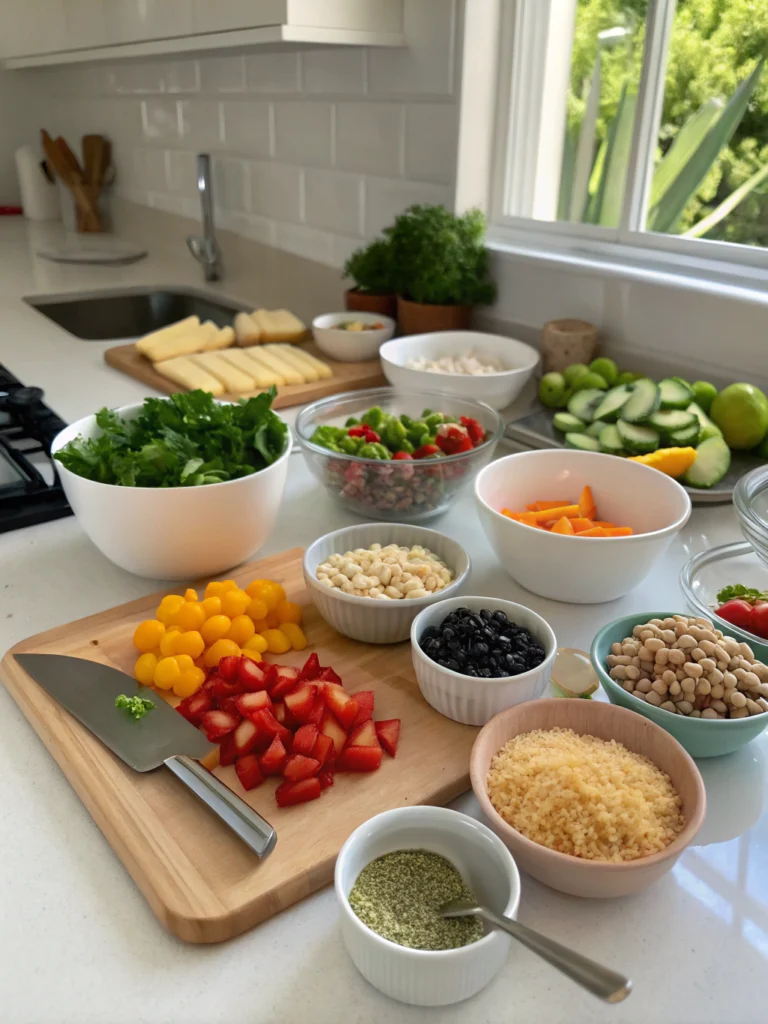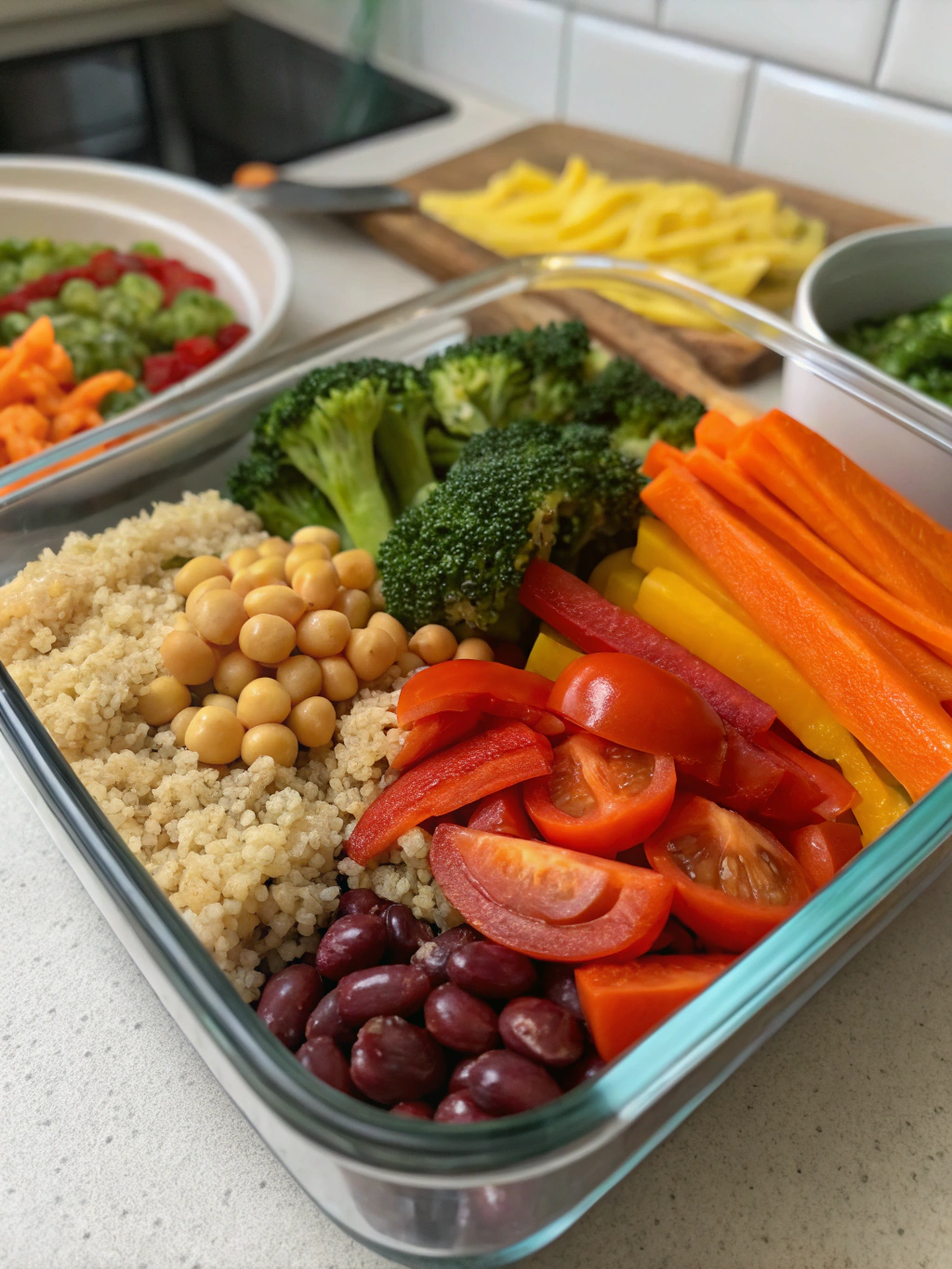Ever wondered how to switch to a plant-based diet without spending hours in the kitchen or going over budget?
With this vegan meal prep plan, you’ll do it the easy way!
Many believe that 7-day vegan meal prep for beginners is expensive, time-consuming, and lacking in protein. But what if we told you it could be budget-friendly, efficient, and packed with plant-based protein?
This beginner-friendly vegan meal prep guide makes healthy eating simple and affordable. From smart shopping lists to easy storage tips, you’ll learn how to save time and enjoy nutritious high-protein meals every day—without stress.
Whether you’re trying to reduce your carbon footprint, improve your health, or simply add more plants to your plate, this plan walks you through every step—making it easy, delicious, and sustainable.
Whether you’re prepping lunches, dinners, or snacks, this vegan meal prep plan gives you structure, saves time, and keeps your meals balanced all week.
This vegan meal prep plan gives you structure, saves time, and keeps your meals balanced all week.
Ingredients List

Here’s everything you’ll need for a full week of vegan meals that won’t strain your wallet. These ingredients create the foundation for varied, protein-rich dishes that will keep you satisfied all week long.
Proteins
- 2 blocks extra-firm tofu ($5)
- 3 cans chickpeas ($3)
- 2 cans black beans ($2)
- 1 can lentils ($1)
- 1/2 cup peanut butter ($2)
- 1 package tempeh (optional upgrade, $4)
Grains & Starches
- 2 cups brown rice ($1.50)
- 1 cup quinoa ($2)
- 2 sweet potatoes ($2)
- 5 regular potatoes ($3)
- 1 package whole grain wraps ($3)
- 1 loaf whole grain bread ($3)
Vegetables
- 2 bell peppers ($2)
- 1 bunch kale ($2.50)
- 1 bag spinach ($3)
- 3 carrots ($1)
- 2 zucchini ($2)
- 1 head broccoli ($2)
- 1 cucumber ($1)
- 1 red onion ($0.75)
- 1 yellow onion ($0.75)
- 1 head garlic ($0.50)
- 1 bag frozen mixed vegetables ($2)
Fruits
- 7 bananas ($2)
- 1 bag frozen berries ($3)
- 3 apples ($2)
- 2 lemons ($1)
Pantry Essentials
- Olive oil
- Soy sauce or tamari
- Maple syrup or agave
- Nutritional yeast
- Salt, pepper, cumin, paprika, garlic powder, Italian herbs
- Flaxseeds or chia seeds
- Oats
Substitution tip: Can’t find or afford an ingredient? Swap quinoa for millet, tofu for chickpeas, or fresh vegetables for frozen alternatives. The beauty of vegan meal prep is its flexibility!
Timing
Total prep time: 2.5 hours (one weekend session)
Daily assembly time: 5-10 minutes per meal
Weekly cooking time: 30% less than preparing individual meals each day
This meal prep approach saves approximately 4-5 hours per week compared to daily cooking. The initial 2.5-hour investment yields 15+ ready-to-assemble meals, averaging just 10 minutes of preparation time per meal—a significant efficiency boost for busy individuals.
Step-by-Step Instructions

Step 1: Prep Your Proteins for Vegan Meal Prep
Start by preparing your protein bases that will form the foundation of multiple meals throughout the week.
- Press and drain tofu for 20 minutes, then cut into cubes
- Toss half the tofu with 1 tbsp soy sauce, 1 tbsp nutritional yeast, and 1 tsp garlic powder
- Bake seasoned tofu at 400°F for 25-30 minutes until golden and crispy
- Rinse and drain all canned beans and lentils
- Season half the chickpeas with cumin, paprika, and a drizzle of olive oil, then roast at 400°F for 20 minutes
Pro tip: Marinate the remaining tofu in different seasonings (like BBQ or teriyaki) for variety throughout the week. Store in separate containers to maintain flavors.
Step 2: Cook Your Grains
Prepare your complex carbohydrates that will pair with your proteins and vegetables.
- Cook brown rice according to package instructions (typically 2 cups water to 1 cup rice for 40-45 minutes)
- Prepare quinoa using a 2:1 water-to-grain ratio, simmering for 15-20 minutes
- Wash and poke holes in sweet potatoes, then bake at 400°F for 45-60 minutes until soft
- Cut regular potatoes into cubes, toss with olive oil and herbs, and roast at 425°F for 25-30 minutes
Time-saving hack: Use a rice cooker or Instant Pot to prepare multiple grains simultaneously while you work on other components.
Step 3: Prepare Your Vegetables
Chop, roast, and steam vegetables for quick meal assembly throughout the week.
- Wash, chop, and store raw vegetables like bell peppers, carrots, and cucumber
- Slice zucchini, toss with olive oil and Italian herbs, and roast at 425°F for 15 minutes
- Steam broccoli for 5 minutes until bright green but still crisp
- Sauté kale with garlic and a splash of water until wilted
- Dice and sauté onions until translucent, then store for quick flavor additions
Efficiency tip: Roast multiple vegetables on the same baking sheet, separated by type, to maximize oven usage and minimize cleanup.
Step 4: Prepare Sauces and Dressings
Create simple, flavorful sauces that will transform your basic ingredients into exciting meals.
- Basic tahini sauce: Blend 1/4 cup tahini, juice of 1 lemon, 1 garlic clove, and water to desired consistency
- Simple peanut sauce: Mix 3 tbsp peanut butter, 1 tbsp soy sauce, 1 tbsp maple syrup, and water to thin
- Lemon herb dressing: Combine juice of 1 lemon, 2 tbsp olive oil, 1 tsp dried herbs, salt and pepper
Storage tip: Keep sauces in small jars or containers and add fresh herbs or spices just before serving to maintain vibrant flavors.
Step 5: Assemble Meal Components
Organize your prepped ingredients for easy meal assembly throughout the week.
- Store cooked grains in airtight containers (they’ll last 3-4 days in the refrigerator)
- Keep roasted and raw vegetables separate to maintain texture
- Portion proteins into serving sizes for quick grabbing
- Store sauces separately and add just before eating
Organization tip: Use clear containers and label with dates to keep track of freshness. Consider portioning complete meals for grab-and-go convenience.
Nutritional Info for Your 7-Day Vegan Meal Prep
This 7-day vegan meal prep plan provides approximately:
Daily averages (based on 2,000 calorie diet):
- Protein: 60-75g (exceeding the RDA of 0.8g/kg body weight)
- Fiber: 30-40g (surpassing the recommended 25g daily intake)
- Iron: 18mg (100% of daily requirements)
- Calcium: 800mg (80% of daily requirements)
- Vitamin B12: Dependent on fortified foods or supplements
- Omega-3 fatty acids: 2-3g (from flaxseeds and chia seeds)
Cost efficiency: This meal plan averages $4-5 per day, approximately 40% less expensive than comparable omnivorous meal plans and 60% less than eating out for a single meal.
Healthier Alternatives for the Recipe
While this meal plan is already health-focused, here are some modifications to address specific dietary needs:
- Lower sodium: Use low-sodium beans, skip added salt, and create herb-based seasonings
- Gluten-free: Replace bread and wraps with corn tortillas or lettuce wraps, and use tamari instead of soy sauce
- Oil-free: Steam-sauté vegetables with vegetable broth instead of oil, and use water or plant milk in dressings
- Higher protein: Add hemp seeds to meals, incorporate more tempeh, or include a plant-based protein powder in morning smoothies
- Lower carb: Increase vegetable portions while reducing grains, and use cauliflower rice as a grain alternative
Nutrient-boosting tip: Add 1 tablespoon of ground flaxseed to your morning oatmeal or smoothie to increase omega-3 fatty acids and fiber content significantly.
Serving Suggestions
Transform your prepped components into exciting meals throughout the week:
- Breakfast options: Overnight oats with berries and flaxseeds; tofu scramble with sautéed vegetables; smoothie bowls with frozen fruit and nut butter
- Lunch combinations: Buddha bowls with grains, roasted vegetables, and tahini sauce; wraps filled with hummus, fresh vegetables, and roasted chickpeas; hearty salads with beans and lemon dressing
- Dinner ideas: Stir-fry with tofu and vegetables over brown rice; loaded sweet potatoes with black beans and avocado; lentil curry with quinoa
- Snack options: Apple slices with peanut butter; roasted chickpeas; vegetable sticks with hummus
Presentation tip: Arrange Buddha bowls in a circular pattern with the grain as the base, proteins and vegetables in separate sections, and sauce drizzled on top for an Instagram-worthy meal that’s as beautiful as it is nutritious.
Common Mistakes to Avoid
- Overcooking grains and vegetables: Slightly undercook components that will be reheated to prevent mushiness
- Neglecting protein sources: Ensure each meal contains at least one protein-rich ingredient like beans, tofu, or tempeh
- Storing wet ingredients with dry ones: Keep components separate until serving to maintain texture and prevent sogginess
- Preparing too much at once: Start with a 3-4 day prep plan before attempting a full week to prevent food waste
- Forgetting variety: Use different spices and sauces to create distinct flavor profiles from the same base ingredients
- Ignoring proper cooling: Allow hot foods to cool completely before refrigerating to maintain food safety
Storing Tips for the Recipe
Maximize freshness and minimize food waste with these storage strategies:
- Store cooked grains and proteins for 3-4 days in airtight containers in the refrigerator
- Keep cut raw vegetables in water-filled containers to maintain crispness (change water daily)
- Freeze extra portions of cooked beans, grains, and roasted vegetables for up to 3 months
- Store sauces and dressings in small jars with tight lids for up to 5 days
- Keep herbs fresh by storing them upright in water like flowers, covered loosely with a plastic bag
- Label all containers with contents and preparation date
Freezer hack: Freeze leftover cooked grains in ice cube trays or muffin tins for perfect single-serving portions that defrost quickly.
Conclusion
Embracing vegan meal prep doesn’t have to be complicated or expensive. This 7-day plan proves that with just a few hours

